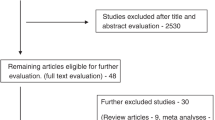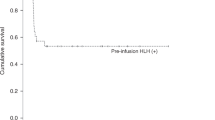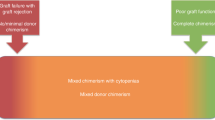Abstract
Engraftment syndrome (ES) is increasingly observed in patients who receive auto-SCT. To investigate this fact, validate the clinical criteria for ES diagnosis and analyze the risk factors for this complication, we reviewed 328 consecutive peripheral blood auto-SCT performed during the past 7 years. A total of 43 patients presented with clinical or biological data suggestive of ES. Of the total, 41 (95%) and 22 (51%) could be diagnosed with ES using the Maiolino criteria (MC) and the Spitzer criteria (SC), respectively. The SC were less sensitive as they do not consider some relevant clinical data and limit the observation time after engraftment. All ES cases had high C-reactive protein (CRP) values not observed in the remaining patients at engraftment (median±s.d.: 17.5±7.3 vs 2.4±3.4 mg per 100 ml; P=0.0001). Multivariate analysis showed a higher risk of ES in SCT performed in recent years (relative risk (RR) 2.3, 95% confidence interval (CI 1.0–4.7), female patients (RR 2.5, 95% CI 1.2–5.2), and absence of intensive chemotherapy before SCT (RR 8.8, 95% CI 3.3–20.5). All patients except one improved after treatment with corticosteroids. The MC seem to be the best tool to establish a diagnosis of ES. In doubtful cases, the diagnosis could be confirmed by evaluating CRP. Auto-SCT in patients not receiving previous chemotherapy could explain the increasing incidence of ES in the past years.
This is a preview of subscription content, access via your institution
Access options
Subscribe to this journal
Receive 12 print issues and online access
$259.00 per year
only $21.58 per issue
Buy this article
- Purchase on Springer Link
- Instant access to full article PDF
Prices may be subject to local taxes which are calculated during checkout


Similar content being viewed by others
References
Lee CK, Gingrich RD, Hohl RJ, Ajram KA . Engraftment syndrome in autologous bone marrow and peripheral stem cell transplantation. Bone Marrow Transplant 1995; 16: 175–182.
Moreb JS, Kubilis PS, Mullins DL, Myers L, Youngblood M, Hutcheson C . Increased frequency of autoaggression syndrome associated with autologous stem cell transplantation in breast cancer patients. Bone Marrow Transplant 1997; 19: 101–106.
Capizzi SA, Kumar S, Huneke NE, Gertz MA, Inwards DJ, Litzow MR et al. Peri-engraftment respiratory distress syndrome during autologous hematopoietic stem cell transplantation. Bone Marrow Transplant 2001; 27: 1299–1303.
Spitzer TR . Engraftment syndrome following hematopoietic stem cell transplantation. Bone Marrow Transplant 2001; 27: 893–898.
Rabinowitz J, Petros WP, Stuart AR, Peters WP . Characterization of endogenous cytokine concentrations after high-dose chemotherapy with autologous bone marrow support. Blood 1993; 81: 2452–2559.
Oyama Y, Cohen B, Traynor A, Brush M, Rodriguez J, Burt RK . Engraftment syndrome: a common cause for rash and fever following autologous hematopoietic stem cell transplantation for multiple sclerosis. Bone Marrow Transplant 2002; 29: 81–85.
Dispenzieri A, Lacy MQ, Hayman SR, Kumar SK, Buadi F, Dingli D et al. Peripheral blood stem cell transplant for POEMS syndrome is associated with high rates of engraftment syndrome. Eur J Haematol 2008; 80: 397–406.
Maiolino A, Biasoli I, Lima J, Portugal AC, Pulcheri W, Nucci M . Engraftment syndrome following autologous hematopoietic stem cell transplantation: definition of diagnostic criteria. Bone Marrow Transplant 2003; 31: 393–397.
Carreras E, Saiz A, Marín P, Martinez C, Rovira M, Villamor N et al. CD34+ selected autologous peripheral blood stem cell transplantation for multiple sclerosis: report of toxicity and treatment results at one year of follow-up in 15 patients. Haematologica 2003; 88: 306–314.
Ravoet C, Feremans W, Husson B, Majois F, Kentos A, Lambermont M et al. Clinical evidence for an engraftment syndrome associated with early and steep neutrophil recovery after autologous blood stem cell transplantation. Bone Marrow Transplant 1996; 18: 943–947.
Fassas AB, Miceli MH, Grazzlutti M, Dong L, Barlogie B, Anaissie E . Serial measurement of serum C-reactive protein levels can identify patients at risk for severe complications following autologous stem cell transplantation. Leuk Lymphoma 2005; 46: 1159–1161.
Ortega M, Rovira M, Almela M, de la Bellacasa JP, Carreras E, Mensa J . Measurement of C-reactive protein in adults with febrile neutropenia after hematopoietic cell transplantation. Bone Marrow Transplant 2004; 33: 741–744.
González-Vicent M, Ramírez M, Sevilla J, Pérez A, Fernández S, Madero L et al. Engraftment syndrome after autologous peripheral blood progenitor cell transplantation in pediatric patients: a prospective evaluation of risk factors and outcome. Bone Marrow Transplant 2004; 34: 1051–1055.
Edenfield WJ, Moores LK, Goodwin G, Lee N . An engraftment syndrome in autologous stem cell transplantation related to mononuclear cell dose. Bone Marrow Transplant 2000; 25: 405–409.
Acknowledgements
We thank Professor A Maiolino et al. (University Hospital, Universidade Federal do Rio de Janeiro, Rio de Janeiro, Brazil) for clarifying the correct interpretation of their clinical criteria. This work was supported in part by the Grants DJCLS-R07/41v of the Deutsche José Carreras Leukämie-Stiftung e.V. and the FIS PI080156 of the Instituto de Salud Carlos III.
Author information
Authors and Affiliations
Corresponding author
Ethics declarations
Competing interests
The authors declare no conflict of interest.
Rights and permissions
About this article
Cite this article
Carreras, E., Fernández-Avilés, F., Silva, L. et al. Engraftment syndrome after auto-SCT: analysis of diagnostic criteria and risk factors in a large series from a single center. Bone Marrow Transplant 45, 1417–1422 (2010). https://doi.org/10.1038/bmt.2009.363
Received:
Revised:
Accepted:
Published:
Issue Date:
DOI: https://doi.org/10.1038/bmt.2009.363



